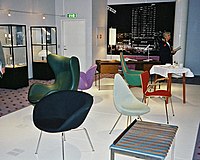Arne Jacobsen
After a spell as an apprentice mason, Jacobsen was admitted to the Architecture School at the Royal Danish Academy of Fine Arts where from 1924 to 1927 he studied under Kay Fisker and Kaj Gottlob, both leading architects and designers.
Before leaving the Academy, Jacobsen also travelled to Germany, where he became acquainted with the rationalist architecture of Mies van der Rohe and Walter Gropius.
[7] In 1929, in collaboration with Flemming Lassen, he won a Danish Architect's Association competition for designing the "House of the Future" which was built full scale at the subsequent exhibition in Copenhagen's Forum.
[11] Soon afterwards, he won a competition from Gentofte Municipality for the design of a seaside resort complex in Klampenborg on the Øresund coast just north of Copenhagen.
The various components of the resort became his major public breakthrough in Denmark, further establishing him as a leading national proponent of the International Modern Style.
Jacobsen designed everything from the characteristic blue-striped lifeguard towers, kiosks and changing cabins to the tickets, season cards and even the uniforms of the employees.
[12] The focal point of the area was supposed to have been a lookout tower, more than a hundred metres high with a revolving restaurant at the top but it was abandoned after huge local protests.
In 1934, came the Bellavista residential development, built in concrete, steel and glass, with smooth surfaces and open floor planning, free of any excesses or ornaments.
[12] These early works clearly show the influence of the White Cubist architecture Jacobsen had encountered in Germany, particularly at the Weissenhof Estate in Stuttgart.
[13] Despite considerable public opposition to his avant-garde style, Jacobsen went on to build Stelling House on Gammeltorv, one of Copenhagen's most historic squares.
During World War II, scarcity of building materials and Nazi racial laws against Jewish citizens made assignments difficult to obtain.
Along with other Jewish Danes and with the help of the Danish resistance, he fled Denmark, rowing a small boat across Øresund to neighboring Sweden where he would stay for the next two years.
After some years Jacobsen got his career back on track and with projects such as the Allehusene complex from 1952 and his Søholm terraced houses from 1955, he embarked on a more experimental phase.
[16] Rødovre Town Hall, built from 1952 to 1956, shows how well Jacobsen combined the use of different materials: sandstone, two types of glass, painted metalwork and stainless steel.
The Munkegaard School consists of pavilions connected by glass corridors, arranged in a grid system around small courtyards.
A delegation of Oxford dons visited the SAS Hotel and the Munkegård School in their search for an architect for St Catherine's College.
Jacobsen's greatest contribution to the furniture genre came in 1951–52 with his three-legged "Ant "chair which was created for functionality being constructed with laminated veneered plywood housed on of chrome legs that were condensed and stackable for economy of space.
In an interview he said; "The proportion is exactly what makes the beautiful ancient Egyptian temples [...] and if we look at some of the most admired buildings of the Renaissance and Baroque, we notice that they were all well-proportioned.













